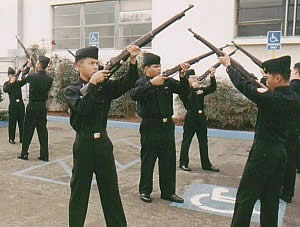
|
School Violence: — Rick Jahnkow |
 photo: COMD |
|||
|
When a student takes a gun to school and goes on a shooting rampage — as one 15-year-old is charged with doing in a community near me in California — the public immediately expresses its shock and confusion over how such a thing could ever occur. Educators, politicians and the mental health professionals who are called upon to deal with this sort of tragedy all struggle to come up with a plausible explanation. Usually, their attention focuses on narrow, individualistic conditions that might provoke such a violent outburst. The American Psychological Association’s brochure, "Warning Signs of Teen Violence" (http://helping.apa.org/warningsigns/), advises us that factors that contribute to teen violence include:
One also hears frequent mention of faulty parenting, a lack of counseling and bullying by peers as factors in school violence. Looking beneath the surface While all of these conditions can certainly play a triggering or facilitating role in violent behavior, they don’t really speak to the deeper, societal influences that come into play when people elect violence as their response to the stressful conditions that surround them. For example, the mere presence of a gun at home may make it easier to commit violence, but it does not explain what inspires a student to take it to school and actually use it. To understand this, one must look more deeply at the culture and values that are instilled in people beginning at an early age. In particular, it is important to acknowledge and take into account the dehumanizing influence of militarism on the socialization process. The relationship between school shootings and militarism has become more apparent to me personally because of the work that I do for the Project on Youth and Non-Military Opportunities (Project YANO), an educational organization that reaches out to young people in San Diego County high schools. San Diego is also the location of one of the largest military complexes in the world. Project YANO provides students with information on careers in social change and peacemaking and non-military alternatives for job training and college financing. With the help of anti-war military veterans, we also educate young people about the realities of war and the military that are not revealed by military recruiters in our high schools. One of the schools I have visited for this work is Santana High School, where 15-year-old Andy Williams is accused of killing two people and wounding 13 others in a shooting spree on March 5, 2001. Here are a few facts about the school, the shooting and the community around the school that hint at some of the deeper societal causes of school violence that are usually ignored by the politicians and behavioral "experts":
Militarism and prejudice Behavioral scientists who have studied the phenomenon of rage shootings in U.S. schools have identified a profile that they say is common to most of the attackers. Two of their traits are a sense of victimization and an interest in the military. One study of 18 young shooters ("Class Avenger," by McGee and DeBarnardo, 2001; http://www.sheppardpratt.org/sp_pdf/classavenger.pdf) found that all of them shared these two characteristics. Despite an apparent link to the violence, the "experts" never look at where these particular traits come from or treat them as possible causal factors. In their failure to do so, they ignore a very basic element that underlies and contributes to the problem: the existence of social values broadly influenced by militarism and bigotry. Both belief systems condition people to define social relationships in terms of "us" versus "them," and to see "them" as less than human. And teaching people to hate each other for their differences is a crucial part of the dehumanization process that makes war and violence not only possible, but also inevitable. Challenging the role of the military in our schools There is profound irony in schools being attacked in the U.S. by students fascinated with the military. As primary instruments for socialization and the teaching of values, educational institutions in the U.S. have, for the last decade, been the main focus of efforts by the military to extend its domestic influence. The armed forces have been expanding high school military training programs and developing new ones geared for lower level schools. In addition, official partnerships between individual military units and schools are increasingly being used to facilitate student field trips to military bases and classroom visits by uniformed personnel. Retired aircraft carriers and battleships are being turned into floating war museums, to which entire student bodies are being brought for propagandizing. These various efforts, along with aggressive military recruiting activities and the more general intrusion of militarism in our culture (via movies, music, computer games and the general media), are further popularizing military values and soldiering among young people. In any country where the military is allowed to have such a powerful presence in the educational system, there should be little surprise if even a relatively few students decide to respond to the pressures of life by resorting to mass violence. Our behavior is motivated in large part by our values, and it is inevitable that the strong influence of militarism on those values is going to come out in such a way. Andy Williams, wearing his Navy SEAL sweatshirt, is just one of the latest tragic examples. There will be many more until the problem is confronted from this perspective. A copy of the court ruling granting school access to peace groups in the U.S., along with samples of counter-militarism material for youths, is available at the COMD Web site: http://www.comdsd.org. Contact Project YANO at: P.O. Box 230157, Encinitas, CA 92023; email projyano@aol.com. A slightly different version of this article appeared in Peace News, Nov. 2001, published in Great Britain. This article is from Draft NOtices, the newsletter of the Committee Opposed to Militarism and the Draft (www.comdsd.org). |
||||